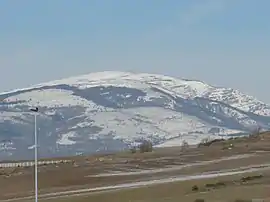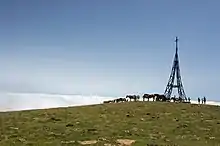Gorbea
Gorbea or Gorbeia is a mountain and massif, the highest in Biscay and Alava (Basque Country, Spain), with a height of 1,481 m AMSL. The massif covers a wide area between the two provinces. The main mountain is a round grass-covered summit where a 20-metre-tall metallic cross has been constructed to reach the altitude of 1,500 m. Other important mountains of the massif are the Berretín (1,227 m), Lekanda (1,301 m) and Aldamin (1,376 m) limestone peaks.
| Gorbea | |
|---|---|
| Gorbeia | |
 Mount Gorbea | |
| Highest point | |
| Elevation | 1,481 m (4,859 ft) |
| Prominence | 866 m (2,841 ft) [1] |
| Coordinates | 43°02′06″N 2°46′48″W |
| Naming | |
| Language of name | Basque |
| Geography | |
| Location | Biscay / Alava, Spain |
| Parent range | Basque mountains |
| Climbing | |
| Easiest route | From Pagomakurre (900 m) |
Part of the massif is delimited North by the high karstic plateau of Itxina, an intrincate landscape of limestone full of shafts and caves such as Supelegor. The Atxular's Eye cave is the only walking access to the plateau. The South is delimited by the Berretín mountain and the lush forests of Zuia.
The entire massif has been enclosed in a natural park of 200 km2 (20,000 ha; 49,000 acres) created by the Basque Government in 1994 to preserve the local flora of beech and oak and fauna of wild boar and deer. The main access points for the mountain are Murgia from Alava and Areatza from Biscay.
Description

The peak of the Gorbea measures 1.482 meters. It is one of the five “bocineros” mountains of Biscay where general meetings are announced with stakes. It is between Alava's and Biscay's frontier. It is accessible from all its slopes and it is surrounded of a natural environment which has been used for agriculture and other type of rural works. This land was inhabited since the beginning of prehistoric life. This place, conserved apart of the civilization, forms the Natural Park of Gorbea. This park is near Urquiola Natural Park. Both of them have a variety of animals and plants diversity.
It has always been so popular for Basque mountaineers who reach the top from all of the slopes. One of the traditions of this mountain is to trek the mountain the last day of the year and the first one. But the most important reference of Gorbea is the cross with the virgin Begoña. Near it, there is mailbox where people can leave their letters.
The cross
In 1899, Pope Leo XIII ordered crosses built on the highest Christian mountains as a sign of the new century. Due to the importance of Catholicism in the Basque Country the crosses were built.
Therefore, the commission of the Basque Country directed by Ceánuri decided to build the cross on the highest mountain of the Basque Country, Gorbea.
The first cross
It was agreed to build a cross of 33.33 meters and it was supposed to be opened in 1900 but it was not possible. After that, in 1901, the work started. However, the budget was only 300 euros. On 12 November 1901, the cross was opened. However, most shepherds expected that the cross would fall within a few days, and they were right. By the next month, the cross had already fallen.
The second cross
No sooner had the first cross fallen down than they were building the second one. This time, the cross had the same height as the first one but it was stronger. 22 month after, the second cross was opened and in the first of October 1903 the cross was blessed with water from the river Jordan. But it was not going to endure for many years. In fact, on 12 February 1906, the cross was pulled down by a gale.
The third cross
In 1907, work began on the third cross. However, the design was much simpler and it was not as tall as the two earlier ones. This one was 17.23 metres long and its structure was very similar to the Eiffel tower. Its base is square and it has 4 feet, 2 in Alava and 2 in Biscay. The structure is much more compact and strong. This time, it was more stable and done by experienced architects. The 4 feet extend diagonally and are joined at the top. Also, it has got a cross in the top pointing the East and the West. At the base, a flame is represented as the light which lights the world. It was built by Serapio de Goikoetxea and Palacio. On 23 June 1963, the religious complex was supplemented with the image of the Virgin Begoña which was installed by the Alpine Group Baskonia.
References
- "Gorbeia, Spain". Peakbagger.com.
External links
| Wikimedia Commons has media related to Gorbeia. |
